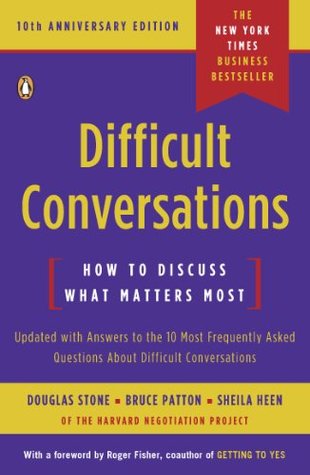More on this book
Community
Kindle Notes & Highlights
Read between
October 20, 2017 - July 18, 2018
The point is this: difficult conversations are almost never about getting the facts right. They are about conflicting perceptions, interpretations, and values.
When competent, sensible people do something stupid, the smartest move is to try to figure out, first, what kept them from seeing it coming and, second, how to prevent the problem from happening again.
Talking about blame distracts us from exploring why things went wrong and how we might correct them going forward. Focusing instead on understanding the contribution system allows us to learn about the real causes of the problem, and to work on correcting them.
Arguing Without Understanding Is Unpersuasive
Our stories are built in often unconscious but systematic ways. First, we take in information. We experience the world – sights, sounds, and feelings. Second, we interpret what we see, hear, and feel; we give it all meaning. Then we draw conclusions about what’s happening. And at each step, there is an opportunity for different people’s stories to diverge.
Two especially important factors in how we interpret what we see are (1) our past experiences and (2) the implicit rules we’ve learned about how things should and should not be done.
Every strong view you have is profoundly influenced by your past experiences.
Don’t choose between the stories; embrace both. That’s the And Stance.
Regardless of what you end up doing, regardless of whether your story influences theirs or theirs yours, both stories matter.
Don’t Assume They Meant It: Disentangle Intent from Impact
The conclusions we draw about intentions based on the impact of others’ actions on us are rarely charitable.
The worse our view of the other person’s character, the easier it is to justify avoiding them or saying nasty things behind their back.
Those are the two classic characteristics of the cycle: both parties think they are the victim, and both think they are acting only to defend themselves. This is how well-intentioned people get themselves into trouble.
When we think others have bad intentions toward us, it affects our behavior. And, in turn, how we behave affects how they treat us. Before we know it, our assumption that they have bad intentions toward us has come true.
The more you can relieve the other person of the need to defend themselves, the easier it becomes for them to take in what you are saying and to reflect on the complexity of their motivations.
And if you start by listening and acknowledging the feelings, and then return to the question of intentions, it will make your conversation significantly easier and more constructive.
I wonder why I didn’t see that?
Abandon Blame: Map the Contribution System
Focusing on blame is a bad idea because it inhibits our ability to learn what’s really causing the problem and to do anything meaningful to correct it.
The distinction between blame and contribution is not always easy to grasp, but it is essential to improving your ability to handle difficult conversations well.
At heart, blame is about judging and contribution is about understanding.
When we blame someone, we are offering them the role of “the accused,” so they do what accused people do: they defend themselves any way they can.
but the actions of both are required for the outcome.
When Blame Is the Goal, Understanding Is the Casualty
By identifying what you are doing to perpetuate a situation, you learn where you have leverage to affect the system. Simply by changing your own behavior, you gain at least some influence over the problem.
This is a common pattern: we frame the problem exclusively as a substantive disagreement and believe that if only we were more skilled at problem-solving, we’d be able to lick the thing. Solving problems seems easier than talking about emotions.
Studies show that while few people are good at detecting factual lies, most of us can determine when someone is distorting, manufacturing, or withholding an emotion.
Because good listening requires an open and honest curiosity about the other person, and a willingness and ability to keep the spotlight on them. Buried emotions draw the spotlight back to us. Instead of wondering, “How does what they are saying make sense?”
The need to understand the basis of the other person’s story intensifies when the disagreement is about interpretations and judgments – about what the facts mean.
First, be careful about rewarding bad behavior. If you give up and hand people what they want simply “to avoid the hassle,” you end up teaching them that behaving badly pays off, and you will soon see more of the same.
Second, beware of reacting in kind or “playing their game.” Remember that your behavior can affect your reputation far beyond this one interaction.
Rather than simply reacting in kind, focus on your objective and how to move toward it.
While we may not agree with their views, it is helpful to understand their logic.
Lots of bosses say they want their employees to challenge them, but far fewer actually mean it.
Control is the unilateral ability to make something happen. Influence is the ability to affect someone else’s thinking.
know there are lots of factors you have to take into consideration, and at the end of the day, I’m onboard with whatever you decide. I just want to make sure that as you think about it, you are aware that. . . .”


